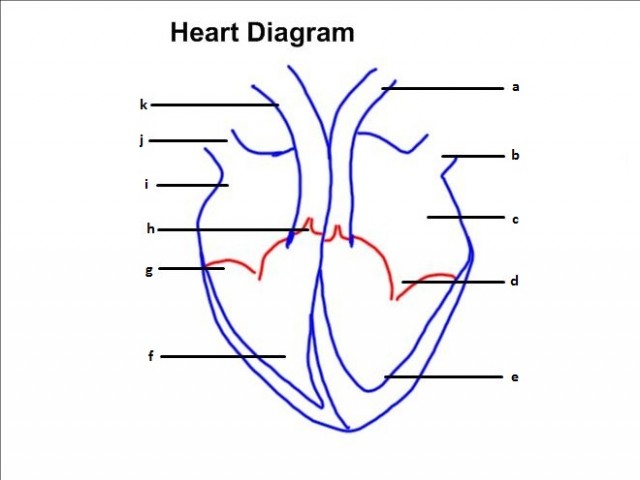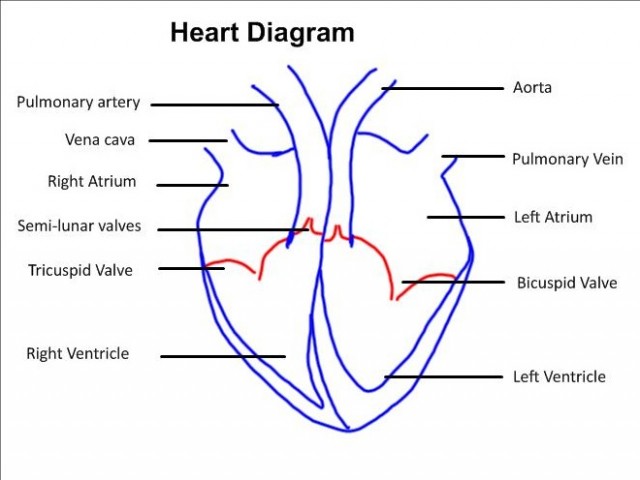Heart Dissection & Diagram
 Understanding the structure and function of the heart.
Understanding the structure and function of the heart.
Using a short screen cast students learn a simple method of drawing a diagram of the heart. Annotations are added and students can practice their knowledge using some printable flashcards or a range of online study methods. Students then extend their knowledge by completing a detailed heart dissection.
Lesson Description
Guiding Question
How can you draw a diagram of a complex organ like the heart in an exam in five minutes?
Why are the muscles thicker in the walls of some chambers and thinner in others?
Activity 1 - Heart Diagram Activities
Using the screen cast below complete a diagram of the structures of the heart including labels
To see an image of the heart diagram click the eye icon

Activity 2: NEW Heart Dissection Experiment (with emphasis on form and function)
Carry out the experiment on the ![]() New Heart dissection worksheet below. Of course this could be a demonstration.
New Heart dissection worksheet below. Of course this could be a demonstration.
Activity 3 Learn annotations for the heart diagram
Check your understanding, study the flashcards below. As you read them through click the star for difficult terms. As you become more confident select one of the other study modes bottom right.
Teachers notes
This lesson could easily take more than 1 hour. It would be wise to plan for this, or set activity one or three as a homework task as follow up or in preparation for the dissection.
The heart dissection has been recently reviewed and completely re-written to emphasise qualitative observations and to ask students to record information about structure and function of the heart, using diagrams and photos. It also improves the way the students see the functioning of the semilunar and atrioventricular valves as well as valves in the coronary veins.
Of course this could be a demonstration or students could work in groups to reduce the use of hearts or if students prefer not to dissect. There is no requirement in IB to carry out dissections.
The older heart dissection was designed as a quantitative IB lab and students are asked to measure and estimate the uncertainty for these measured values. Carry out the experiment on the ![]() Heart dissection worksheet below.
Heart dissection worksheet below.
Should students learn how to draw heart diagrams by heart?
(Please excuse the pun!)
The guide doesn't explicitly say that students have to be able to draw the heart structure. However, the teacher support material which lists the changes in the new guide doesn't say that this has been removed from the topic 6.2.
I have also checked through the specimen exam papers for the 2014-2022 guide and there is a question to label a photo of the heart from a dissection in the SL paper 2, but no question to draw it.
Personally I think that the activity of drawing a heart will help students to remember the names of the parts and also to understand the structure of a heart while they do a dissection. But yes, drawing a diagram of a heart is less likely to be a question in future exams.
The presentation of the IB Biology guide as student understandings and skills allows a wider range of questioning for examiners.
I could imagine a question asking students to explain some of the details listed in the guide, e.g. flow of blood through the heart and the function of valves, using diagrams if they wish to.
A supplimentary activity about heart structure and function
Check understanding could be to write a script, or to describe some of the parts of this super animation of the functioning of the heart from Arcreative media.
Heart structure narration activity idea
- Divide the class into groups of 3-6 students
- Watch the video
 Human heart anatomy once while students note down parts of the heart that they remember.
Human heart anatomy once while students note down parts of the heart that they remember. - Groups spend 5 minutes sharing their answers and deciding who will name each part in the video.
- Replay the video so that groups can do a quiet practise - simultainiously in the class.
- It may be necessary for groups to make changes to their ideas and improve their narration (3 minutes)
- Then play the video with the sound turned low, and ask the first group to stand up and 'Narrate the parts of the heart that they see in the video'
- Replay the video with each group in turn.
- Spectators can record how many parts of the heart have been correctly annotated by each group.
It may be helpful to give out a checklist of parts of the heart.

 IB Docs (2) Team
IB Docs (2) Team
